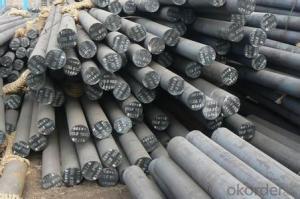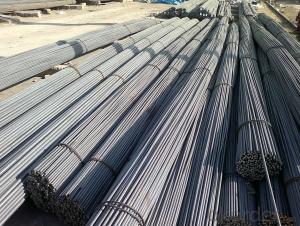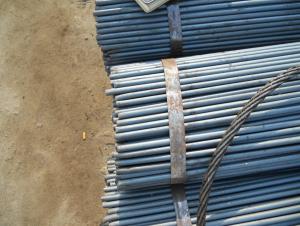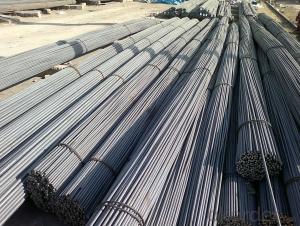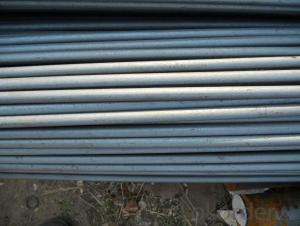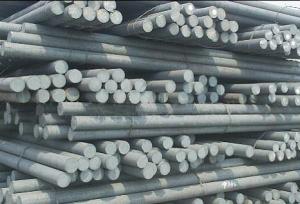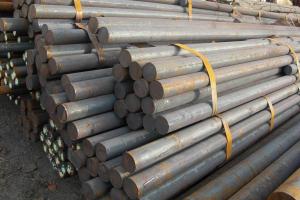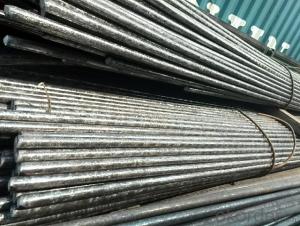Roung BAR
- Loading Port:
- China Main Port
- Payment Terms:
- TT OR LC
- Min Order Qty:
- -
- Supply Capability:
- -
OKorder Service Pledge
OKorder Financial Service
You Might Also Like
Product Description:
Specifications of High Quality Round Bar
1. Grade: GB, JIS, ASTM, EN
2. Grade: Q235, SS400, A36, S235JR
3. Diameter and mass: As below
Diameter | Mass | Diameter | Mass | Diameter | Mass |
(mm) | (kg/m) | (mm) | (kg/m) | (mm) | (kg/m) |
6 | 0.22 | 22 | 2.98 | 53 | 17.30 |
7 | 0.30 | 24 | 3.55 | 56 | 19.30 |
8 | 0.40 | 25 | 3.85 | 60 | 22.20 |
9 | 0.50 | 26 | 4.17 | 63 | 24.50 |
10 | 0.62 | 28 | 4.83 | 65 | 26.00 |
11 | 0.75 | 30 | 5.55 | 70 | 30.20 |
12 | 0.89 | 32 | 6.31 | 75 | 34.70 |
13 | 1.04 | 34 | 7.13 | 80 | 39.50 |
14 | 1.21 | 36 | 7.99 | 85 | 44.50 |
15 | 1.39 | 38 | 8.90 | 90 | 49.90 |
16 | 1.58 | 40 | 9.86 | 95 | 55.60 |
17 | 1.78 | 42 | 10.90 | 100 | 61.70 |
18 | 2.00 | 45 | 12.50 | 120 | 88.85 |
19 | 2.23 | 48 | 14.20 | 140 | 120.93 |
20 | 2.47 | 50 | 15.40 | 150 | 138.82 |
4. Material: Mild Steel
5. Heat treatment of high quality steel:
Fire: Isothermal annealing temperature is 800 ~ 880 °C, with 10 ~ 20 °C, the furnace cooling to about 600 °C, hardness above HB269.
Preheat temperature: 730-730 °C
Quenching temperature: 1190-1210 °C
Tempering temperature: 540-595 °C
Cold drawn, hardness 285 HBS
Cold drawn after annealing condition, hardness 277 HBS
Quenching methods: oil quenching, air cooling or salt bath quenching
Usage and Applications of High Quality Round Bar
1) Suitable for making various strong cutting tool abrasion resistance, impact resistance.
2) Used to produce all kinds of high hard and super hard saw blade, drill, tap, broach, gear hob and various kinds of milling cutter.
3) Used for advanced punching die, screw die, and the toughness and complicated shape of the punch, etc.
4) Is used for cold forging die and drawing mode, etc.
5) Recommended watchcase factory, screw factory and other cold stamping products industry use.
Packaging & Delivery of High Quality Round Bar
Packaging Detail: All goods are packed in bundle with steel strips and shipped by break bulk vessel or container (depend on target market and different ports)
Delivery Detail: 45 days
Trade terms: FOB, CFR, CIF
MOQ: 25 tons per specification; we can negotiate the quantity if the specification is normal or we have stock of one specification.
Weight: Theprice invoicing on theoretical weight basis or actual weight basis depends on customer’s request.
Shipment: The shipment of bulk break or container is depends on customer’s request and the situation of the port of destination.
Documents given: Full set of original clean on board bill of lading; Original signed commercial invoice; Original packing list; Policy of insurance; Certificate of origin and what the target market needs.
Production Flow of High Quality Round Bar
The common processes are preheated forging quenching, dual refinement solution process, cooling quenching and isothermal quenching. We use heat treatment for dual refinement solution process. The main measures process is high temperature solution and refinement cycle. High temperature solution can improve the carbide morphology and particle size. The aim is to make the loop refinement ultrafine austenite grains.
- Q: Can steel round bars be used for making connecting rods?
- Yes, steel round bars can be used for making connecting rods. Connecting rods are vital components in internal combustion engines, and they require high strength and durability to withstand the forces and stresses involved in the engine's operation. Steel round bars, typically made from alloy steel, have excellent mechanical properties such as high tensile strength, hardness, and fatigue resistance, making them suitable for this application. Furthermore, steel round bars can be easily machined and shaped into the desired dimensions and specifications required for connecting rods. Therefore, using steel round bars is a common and reliable choice for manufacturing connecting rods in the automotive and other industries.
- Q: What is the maximum weight of a steel round bar?
- The maximum weight of a steel round bar depends on its diameter and length. The weight can vary from a few pounds to several tons for larger and longer bars.
- Q: What is the yield strength of a steel round bar?
- The yield strength of a steel round bar can vary depending on the specific grade and type of steel used. However, common structural steel grades have yield strengths ranging from 250 MPa to 800 MPa.
- Q: Are steel round bars magnetic?
- Yes, steel round bars can be magnetic. The magnetic properties of steel depend on its composition and processing. Most commonly used steel alloys, such as carbon steel or stainless steel, contain iron as the main component. Iron is a ferromagnetic material, which means it can be magnetized. Therefore, steel round bars made from these alloys will exhibit magnetic properties. However, it is important to note that the strength of the magnetism can vary depending on the specific composition of the steel. Some stainless steel alloys, for example, have a lower magnetic permeability and may exhibit weaker magnetic properties compared to carbon steel.
- Q: How do steel round bars compare to fiberglass round bars?
- Steel and fiberglass round bars possess distinct characteristics and applications, rendering them appropriate for diverse purposes. Renowned for their robustness and resilience, steel round bars are commonly utilized in the construction, manufacturing, and engineering sectors, where strength and load-bearing capacity assume paramount importance. With the ability to endure heavy loads, steel round bars prove ideal for structural applications like beams, columns, and supports. Furthermore, steel round bars exhibit exceptional resistance to impact, wear, and corrosion, rendering them fitting for outdoor and high-stress environments. Conversely, fiberglass round bars offer exclusive advantages. Fiberglass, being both lightweight and non-conductive, finds suitability in applications where electrical conductivity or weight constitutes a concern. Frequently employed in the electrical and telecommunications industries, fiberglass round bars provide insulation and enhance safety. Moreover, they exhibit resistance to corrosion, making them appropriate for outdoor and marine applications. Considering cost, steel round bars generally prove more affordable than their fiberglass counterparts. Given the wide availability of steel and its relatively low production costs, it serves as a cost-effective material. Conversely, fiberglass necessitates specialized manufacturing processes and materials, thereby potentially increasing its overall cost. Ultimately, the selection between steel and fiberglass round bars hinges on the specific requirements of the intended application. Should strength, durability, and load-bearing capacity hold critical significance, steel round bars emerge as an excellent choice. However, if considerations such as weight, electrical insulation, or corrosion resistance assume prominence, fiberglass round bars may prove more suitable.
- Q: Are steel round bars suitable for machining operations?
- Yes, steel round bars are suitable for machining operations. Steel is known for its high strength and durability, making it an excellent material for various machining processes. Steel round bars can be easily shaped, cut, drilled, and turned to create precise components or parts. Machining operations such as milling, drilling, and turning can be efficiently performed on steel round bars to achieve the desired shape, size, and finish. Additionally, steel round bars offer good dimensional stability and excellent mechanical properties, allowing for accurate and consistent machining results. Overall, steel round bars are a reliable choice for machining operations in various industries including automotive, aerospace, construction, and manufacturing.
- Q: What is the yield strength to tensile strength ratio of a steel round bar?
- The yield strength to tensile strength ratio of a steel round bar is typically around 0.85.
- Q: Can steel round bars be used in the production of springs?
- Yes, steel round bars can be used in the production of springs. Steel is a common material used in the manufacturing of springs due to its high strength and durability. Steel round bars are often used to create the base material for springs, as they can be easily shaped and formed into the desired spring shape. Additionally, steel round bars can be heat-treated to enhance their mechanical properties, making them suitable for various spring applications. The specific type of steel used will depend on the desired characteristics and requirements of the spring, such as the desired level of flexibility and resistance to deformation. Overall, steel round bars are widely utilized in the production of springs due to their excellent mechanical properties, making them a suitable choice for many spring applications.
- Q: Are steel round bars suitable for the production of hydraulic cylinders?
- Steel round bars are indeed appropriate for manufacturing hydraulic cylinders. Steel is renowned for its robustness, longevity, and resistance to corrosion, thus making it an exceptional option for hydraulic purposes. Due to their exceptional tensile strength and capacity to endure substantial loads and pressure, steel round bars are frequently employed in the construction of hydraulic cylinders. Furthermore, steel can be effortlessly machined and welded, enabling accurate production and customization of hydraulic cylinders. In summary, steel round bars possess the essential attributes and capabilities needed for manufacturing hydraulic cylinders.
- Q: What are the different types of steel round bar surface treatments for improved wear resistance?
- There are several different types of steel round bar surface treatments that can be applied to improve wear resistance. These treatments are designed to enhance the hardness, toughness, and overall durability of the steel, making it more resistant to wear and corrosion. Some of the most common surface treatments for steel round bars include: 1. Nitriding: This treatment involves exposing the steel to a nitrogen-rich environment at high temperatures. This forms a hard nitride layer on the surface, which improves wear resistance and provides enhanced hardness. 2. Carburizing: Carburizing is a process that involves introducing carbon into the surface of the steel to create a high-carbon layer. This layer increases hardness and wear resistance, making it suitable for applications that require high strength and durability. 3. Induction hardening: Induction hardening is a heat treatment process that selectively hardens the surface of the steel. This is achieved by heating the steel using an induction coil and then rapidly quenching it. The resulting hardened layer provides excellent wear resistance while maintaining the toughness of the core. 4. Shot peening: Shot peening involves bombarding the steel surface with small metal or ceramic particles at high velocity. This process creates compressive stresses on the surface, which improves fatigue life and wear resistance. 5. Thermal spraying: In thermal spraying, a coating material is melted and sprayed onto the steel surface using a flame or plasma torch. This creates a protective layer that offers enhanced wear resistance and corrosion protection. 6. PVD/CVD coatings: Physical Vapor Deposition (PVD) and Chemical Vapor Deposition (CVD) coatings involve depositing a thin layer of material onto the steel surface. These coatings provide excellent wear resistance, low friction, and improved corrosion protection. 7. Hard chrome plating: This process involves electroplating a layer of chromium onto the steel surface. Hard chrome plating offers high hardness, wear resistance, and corrosion protection. It's important to note that the choice of surface treatment depends on the specific application requirements and the type of wear resistance needed. Each treatment has its own advantages and limitations, and it is crucial to consider factors such as cost, environmental impact, and performance characteristics when selecting the most suitable treatment for a given steel round bar.
Send your message to us
Roung BAR
- Loading Port:
- China Main Port
- Payment Terms:
- TT OR LC
- Min Order Qty:
- -
- Supply Capability:
- -
OKorder Service Pledge
OKorder Financial Service
Similar products
Hot products
Hot Searches
Related keywords
